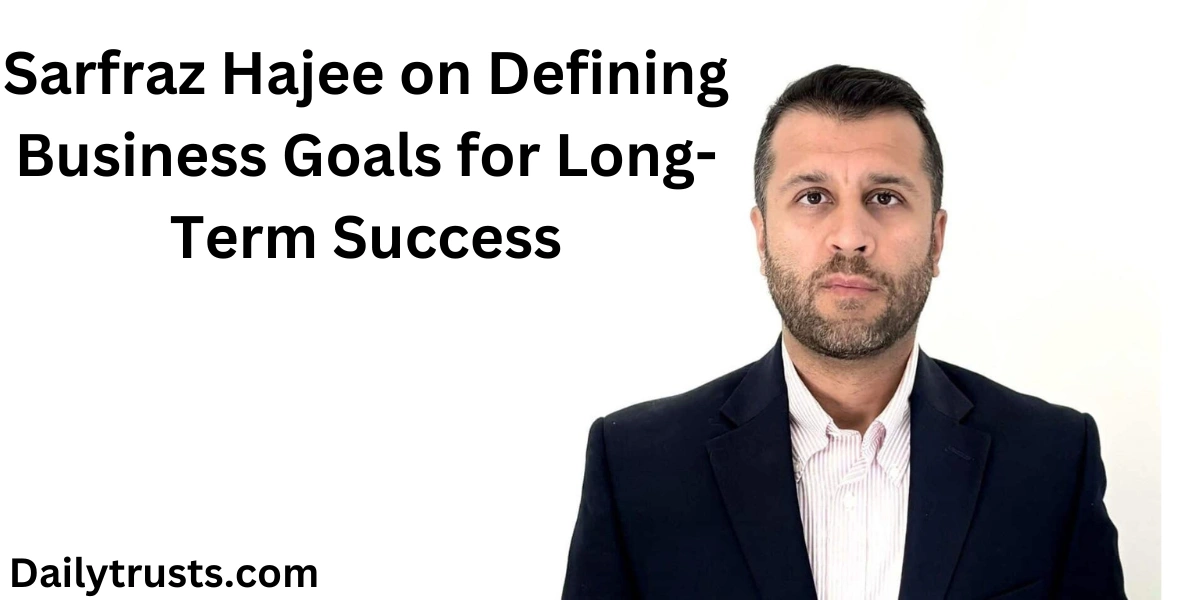Sarfraz Hajee on Defining Business Goals for Long-Term Success
How well businesses develop and achieve their objectives in the business world is frequently used to determine success. Experienced private fund manager and entrepreneur Sarfraz Hajee has spent years helping small firms achieve long-term success and sustainable growth in a variety of economic environments.
Hajee co-founded his first private fund in 2011, and he and his partners used their own funds to launch GHS Investments in 2015. In addition, he actively advises a number of companies and charity organizations on legal and operational matters. His strategic observations provide priceless guidance on how to establish corporate objectives that go beyond immediate financial gain and result in long-term stability and growth.
Who is Sarfraz Hajee?
Sarfraz Hajee is a professional with expertise in various fields, including digital marketing and business strategy. Known for his contributions to the growth of businesses, he has a reputation for providing actionable insights and practical solutions, helping companies optimize their operations and achieve measurable success.
Understanding Profit Margin Types
One key performance indicator (KPI) that shows a company’s general health and effectiveness is its profit margin. Hajee identifies three primary profit margin kinds, each of which provides insightful information about the functioning of a company:
- Gross Profit Margin: Indicates how efficiently items are produced or sourced by subtracting the cost of goods sold from net revenues.
- EBIT, or operating profit margin: This margin, which is sometimes referred to as earnings before interest and taxes, evaluates how well a business makes money from its main activities.
- The percentage of the company’s revenue that is converted to actual net income is shown by the net profit margin.
These metrics can offer crucial data for entrepreneurs looking to increase revenues in order to optimize operations and spur significant advancements.
The Importance of Setting Clear, Long-Term Goals
The importance of long-term planning is one of Hajee’s core ideas. While many entrepreneurs concentrate on short-term issues, such as raising short-term sales or obtaining finance, Hajee stresses the significance of setting long-term objectives that will direct choices in the future.
Setting long-term objectives guarantees that every action a company does is in line with its overarching vision, claims Hajee. This strategy keeps short-term profits from taking precedence over long-term profitability, regardless of the size of your company. “A clear understanding of your long-term vision allows businesses to make informed choices about private capital and growth strategies,” he says in an interview with TechBullion.
Focusing on Operational Excellence
Hajee places a strong focus on operational excellence as part of its startup success strategy. The thrill of starting a firm can sometimes overshadow the necessity of robust, effective systems and procedures for many entrepreneurs. In order to prevent inefficiency and resource waste, Sarfraz Hajee advises businesses to streamline their processes from the outset.
This strategy entails defining roles precisely, creating workflows, and implementing scalable systems. A startup’s chances of long-term, sustainable growth increase with the speed at which it can implement procedures that guarantee seamless daily operations.
“Good business isn’t just about ideas and innovation—it’s about executing them effectively,” Hajee says.”A brilliant concept might quickly be lost in pandemonium if the wrong procedures aren’t in place. In order to concentrate on growth rather than continuous troubleshooting, you must make sure that every component of the puzzle is in place.
Prioritizing Sustainable Growth
Sustainable growth is essential, especially for small enterprises, according to Hajee. Businesses should carefully consider their growth tactics because, in his opinion, increasing too quickly without the proper strategy can result in unsustainable practices. Hajee suggests that businesses pay attention to growth metrics in his post, How Small Businesses Can Scale for Sustainable Growth, to make sure they’re not simply growing but doing so in a way that can be sustained over the long run.
Hajee advises beginning with a precise definition of success that goes beyond monetary indicators. As important markers of long-term success, companies should instead concentrate on operational effectiveness, market share, and customer happiness.
Proven Strategies for Scaling a Business

Hajee provides helpful guidance on how small businesses can scale successfully in another post titled 7 Proven Growth Strategies for Scaling Your Business. He stresses the value of customer-centric strategies, strategic alliances, and wise capital expenditures.
One important lesson to be learned from Hajee’s strategy is that scaling involves more than merely expanding your clientele or creating new sites. Rather, companies need to carefully balance innovation, operational enhancements, and expansion. This guarantees that they can maintain the same standard of quality and customer service as they grow.
Exploring Private Capital Options
Securing the appropriate type of cash is a crucial component of establishing corporate objectives. Not all funding is made equal, according to Hajee. Owners of businesses must think about whether loans, private money, or other forms of funding fit with their long-term objectives.
Hajee describes how private finance might be a great choice for small, startup companies in need of a growth push in his piece on TechBullion. But he also warns against making hasty decisions without fully comprehending the long-term effects. “It’s critical to comprehend how capital affects your company’s trajectory, including profit margins and ownership structure,” he says.
Creating a Culture of Resilience
According to Hajee, fostering resilience in a company is essential to long-term success. This entails cultivating a culture that can adjust to market fluctuations in addition to being financially prepared. Long-term successful companies, in his opinion, are able to change course as needed while retaining their essential goals.
Hajee suggests that businesses invest in their staff and develop a continuous improvement culture in order to promote this resilience. He contends that initiatives for staff involvement, learning opportunities, and frequent feedback loops are essential for maintaining progress.
Sarfraz’s Key Takeaway
For small firms hoping to succeed over the long haul, Sarfraz Hajee’s strategic insights provide a clear road map. His emphasis on resilience building, strategic capital utilization, and sustainable growth results in a well-rounded approach to scaling. Entrepreneurs can create businesses that not only survive but also prosper over the long run by establishing specific objectives that go beyond short-term profits.
Businesses hoping to maintain their position in the market for years to come can use Hajee’s strategies as a guide in an ever-changing business environment.
Adaptability and Continuous Learning
Sarfraz Hajee strongly supports flexibility and lifelong learning. The capacity to change course and adapt tactics is essential for survival in the quickly changing corporate world of today. Hajee counsels business owners to maintain an open mind, welcome novel concepts and be prepared to change direction when needed.
“Things rarely go exactly as planned,” he says, successful Entrepreneurs are able to adjust to change and grow from their errors. Being adaptable and able to spot chances in places you might not have first thought of are frequently the keys to growth.
Conclusion: Sarfraz Hajee on Defining Business Goals for Long-Term Success
The core tenets of Sarfraz Hajee’s strategy for increasing company profits are labor productivity, cost effectiveness, strategic pricing, customer loyalty, and flexibility in response to shifting market conditions. Businesses can position themselves for long-term success and make strategic changes that result in instant improvements by monitoring these important metrics.
Businesses may create a strong basis for long-term success by putting Hajee’s advice into practice. This will enable them to prosper in competitive marketplaces and maintain long-term profitability.
FAQs: Sarfraz Hajee on Defining Business Goals for Long-Term Success
Here are some frequently asked questions about Sarfraz Hajee on Defining Business Goals for Long-Term Success. We’ve provided comprehensive answers to ensure you have all the information you need. If you still have any questions or require further clarification, our team of experts is here to assist you.
Q1. Why is it important to define business goals for long-term success?
Defining clear goals helps businesses stay focused, measure progress, and make informed decisions. Long-term goals provide direction and motivation, ensuring the business can evolve and sustain success over time.
Q2. How does Sarfraz Hajee help businesses set achievable long-term goals?
Sarfraz uses a combination of data analysis, market research, and strategic planning to identify key areas of growth and then sets SMART (Specific, Measurable, Achievable, Relevant, and Time-bound) goals that can be tracked and adjusted as needed.
Q3. What role does digital marketing play in achieving long-term business goals?
Sarfraz emphasizes that digital marketing is critical in expanding a business’s reach, building a strong online presence, and engaging with customers, all of which are vital components of achieving long-term goals.
Q4. How does Sarfraz Hajee advise businesses to measure success over time?
He suggests using KPIs (Key Performance Indicators) and data analytics to track progress against set goals. Regular assessments help businesses refine strategies and make necessary adjustments for sustainable success.
Q5. What common mistakes do businesses make when setting long-term goals?
Many businesses fail to set realistic and achievable goals, or they focus too much on short-term results. Sarfraz recommends avoiding these pitfalls by aligning goals with a clear long-term vision and being flexible to adapt.
Q6. How can businesses stay motivated when working towards long-term goals?
Sarfraz encourages businesses to break long-term goals into smaller, manageable milestones. Celebrating small victories along the way helps maintain momentum and motivation.
